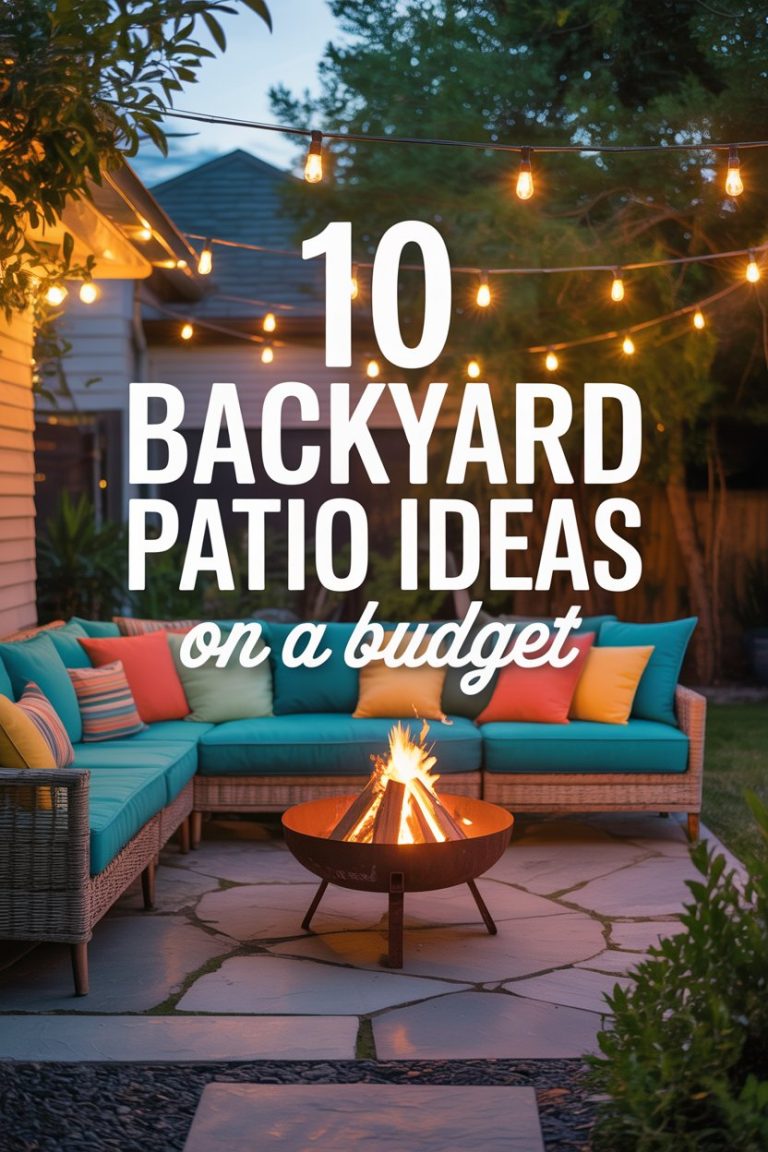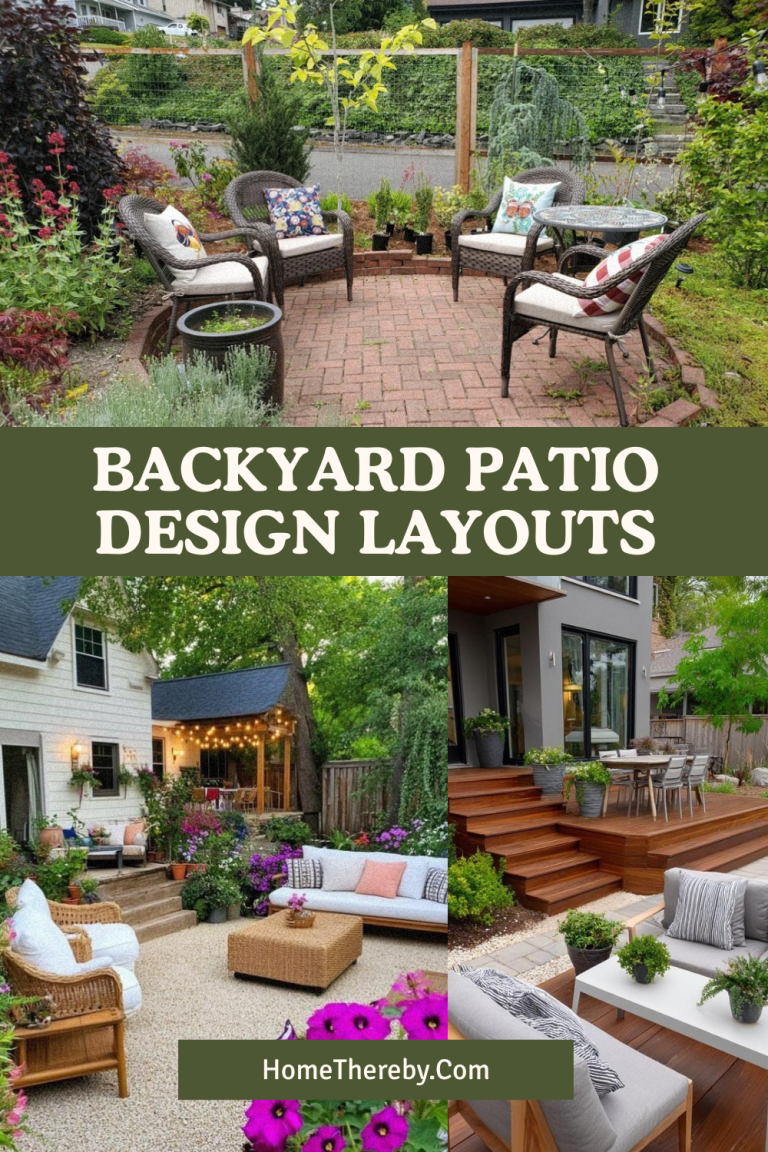10 Small Backyard Patio Designs That Feel Bigger
Ever walk into a backyard and wonder how such a tiny space feels so open and inviting? The secret isn’t size – it’s smart design. With the right layout, lighting, and style choices, even the coziest patio can feel like a private retreat.
That’s why I’ve rounded up 10 small backyard patio designs that prove you don’t need a big yard to live large outdoors.
10 Small Backyard Patio Designs
1. Cozy Bistro Patio
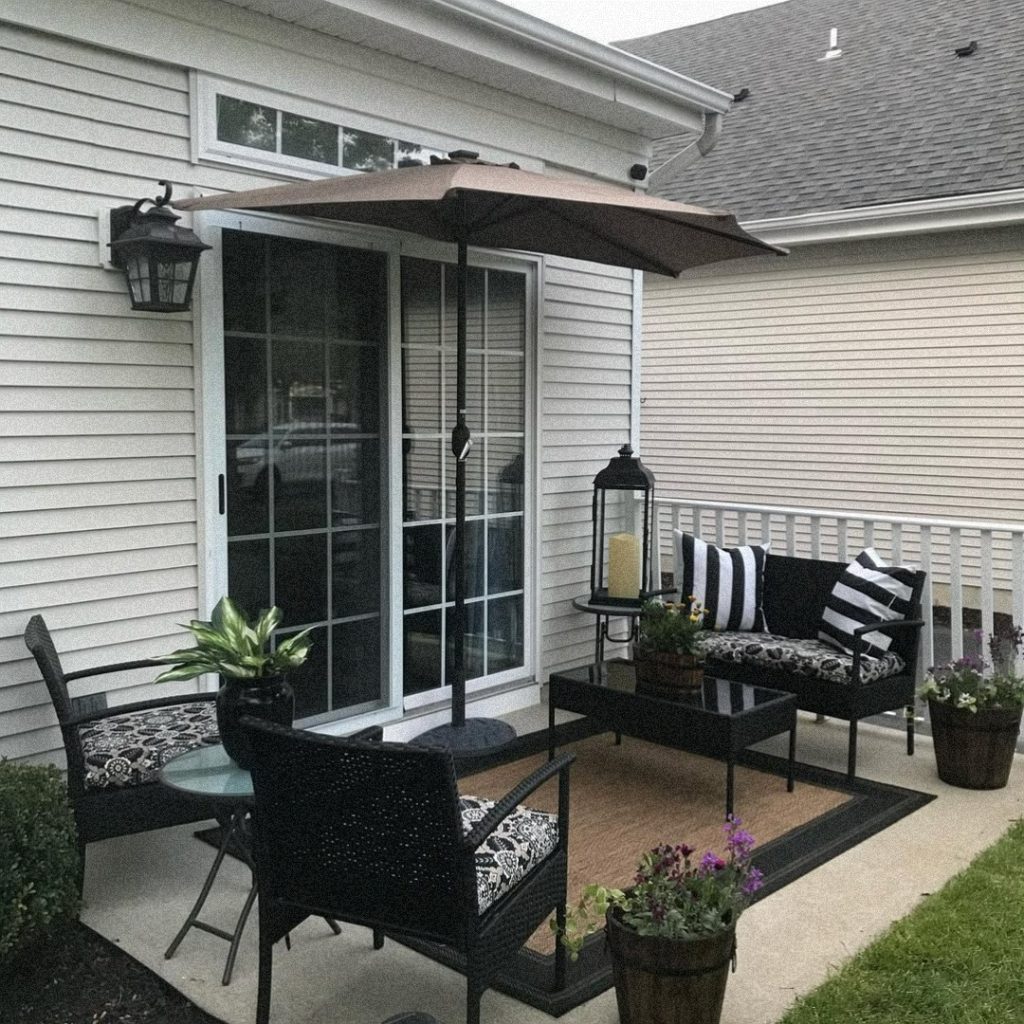
Image: https://www.instagram.com/ourmanorhome/
What Makes It Unique
This patio design uses dark, low-profile furniture and a light rug to create a striking contrast that feels both intimate and open. The strategic placement of potted plants at different heights adds a layered look, drawing the eye and making the space feel more dynamic. It’s a great example of how you can create a cozy, conversation-friendly area without a lot of square footage.
Materials Needed
- Wicker or metal bistro set
- Area rug
- Potted plants
- Large candle lanterns
- Patio umbrella
How to Do It
- Start with the Seating. Choose a small bistro or conversation set that fits your space without crowding it. Dark furniture works well to anchor the area.
- Define the Space with a Rug. Lay down an outdoor rug under the furniture. The contrast between a light rug and dark furniture helps to make the area feel more distinct and spacious.
- Add Greenery. Place potted plants around the seating area to bring in natural elements. Use a mix of sizes and heights to create visual interest.
- Incorporate Lighting. Use large lanterns with candles or LED lights to add a warm, inviting glow, especially for evening use.
- Provide Shade. If your patio gets a lot of sun, a small, free-standing umbrella can provide relief and make the space more comfortable.
2. Pergola-Style Patio
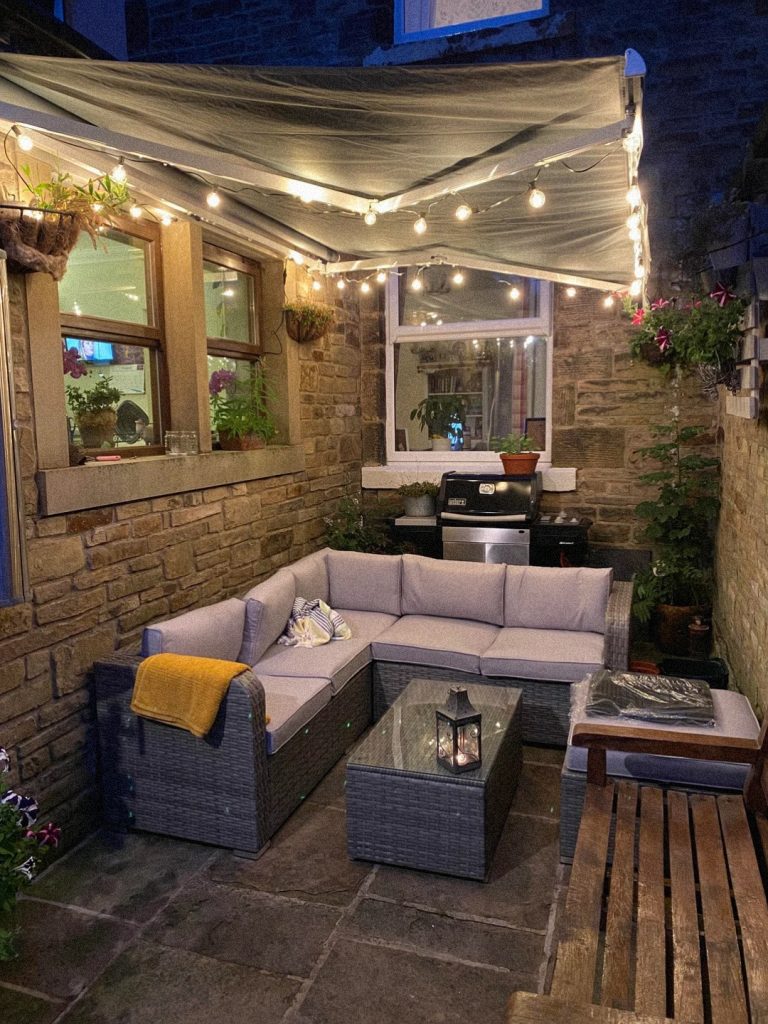
Image: https://www.reddit.com/user/Vipatech/
What Makes It Unique
This design showcases how vertical space can be used to great effect in a small area. The DIY awning with string lights creates the feel of a pergola without the heavy construction, providing both shade and a warm, inviting glow. The L-shaped sectional sofa maximizes seating while fitting snugly into the corner, making the space feel like an outdoor living room.
Materials Needed
- L-shaped wicker or metal sectional sofa
- Awning or shade fabric
- String lights
- Potted plants
- Outdoor pillows and throws
- Coffee table
How to Do It
- Set Up the Seating. Place an L-shaped sectional in the corner of your patio to make the most of the available space. A sofa like this can seat multiple people comfortably without the clutter of several chairs.
- Create a Canopy. Install a simple awning or fabric shade to provide overhead coverage. You can secure it to the side of the house and support it with poles or a simple frame.
- Add Ambiance with Lights. Drape a strand of outdoor string lights under the canopy. This not only illuminates the space but also adds a festive, cozy atmosphere, perfect for evening gatherings.
- Accessorize for Comfort. Finish the space with outdoor pillows and a throw blanket to make it more comfortable and stylish. Place a coffee table in the center to hold drinks and snacks.
- Bring in Plants. Use wall-mounted planters and potted plants to add greenery and softness to the brick walls.
3. A Natural Courtyard Oasis

Image: reddit.com
What Makes It Unique
This patio thrives on a DIY-friendly, rustic aesthetic. The furniture is crafted from repurposed pallets, which adds a unique, eco-friendly, and cost-effective touch. The space is further enhanced by a vertical garden that transforms a plain wall into a lush focal point, maximizing greenery in a small area. This design beautifully integrates natural materials and a handmade feel.
Materials Needed
- Wooden pallets
- Outdoor cushions and pillows
- Outdoor rug
- Vertical garden planters
- Potted plants
- String lights
How to Do It
- Build the Pallet Furniture. Find or purchase heat-treated pallets. Stack them to create a low sofa and a coffee table. Sand them down, and for longevity, consider staining or applying a clear outdoor sealant.
- Add Comfort and Style. Place a comfortable outdoor mattress or large cushions on the pallet sofa. Add a variety of pillows to make it a cozy spot for lounging. Use an outdoor rug to define the seating area and add a layer of texture.
- Create a Vertical Garden. Secure vertical garden planters or a wire grid to a wall. Choose a variety of plants with different textures and colors to fill the pockets, instantly adding a vibrant, green backdrop.
- Hang String Lights. Run strands of outdoor string lights along the top of the wall or around the perimeter of the space to provide a warm, inviting glow for nighttime use.
4. Shaded Oasis with Fire Pit

Image: https://www.reddit.com/user/Logical-Chocolate-18/
What Makes It Unique
This patio uses a dedicated gazebo structure to create an outdoor room feel, offering shade and privacy. The curtains on the gazebo add a touch of elegance and can be drawn for extra seclusion. The inclusion of a fire pit provides a focal point and extends the usability of the patio into cooler evenings, perfect for intimate gatherings.
Materials Needed
- Hardtop gazebo with curtains
- Outdoor sectional sofa
- Accent chair
- Coffee table
- Outdoor rug
- Fire pit
How to Do It
- Install the Gazebo. Begin by setting up a permanent or semi-permanent hardtop gazebo. This structure provides instant shade and defines the patio area. Ensure it’s securely anchored.
- Arrange the Seating. Place an outdoor sectional sofa within the gazebo, maximizing comfort and seating capacity. Add an additional accent chair if space allows to create more varied seating options.
- Define with a Rug. Lay an outdoor rug under the seating area to add warmth, texture, and further delineate the “room” created by the gazebo.
- Add a Fire Pit. Position a fire pit in front of the seating area. This serves as a central feature for ambiance and warmth, making the patio enjoyable even on cooler nights.
- Furnish with a Coffee Table. A low coffee table in the center of the seating arrangement provides a convenient surface for drinks and snacks.
5. An L-Shaped Patio with Two-Zone Seating
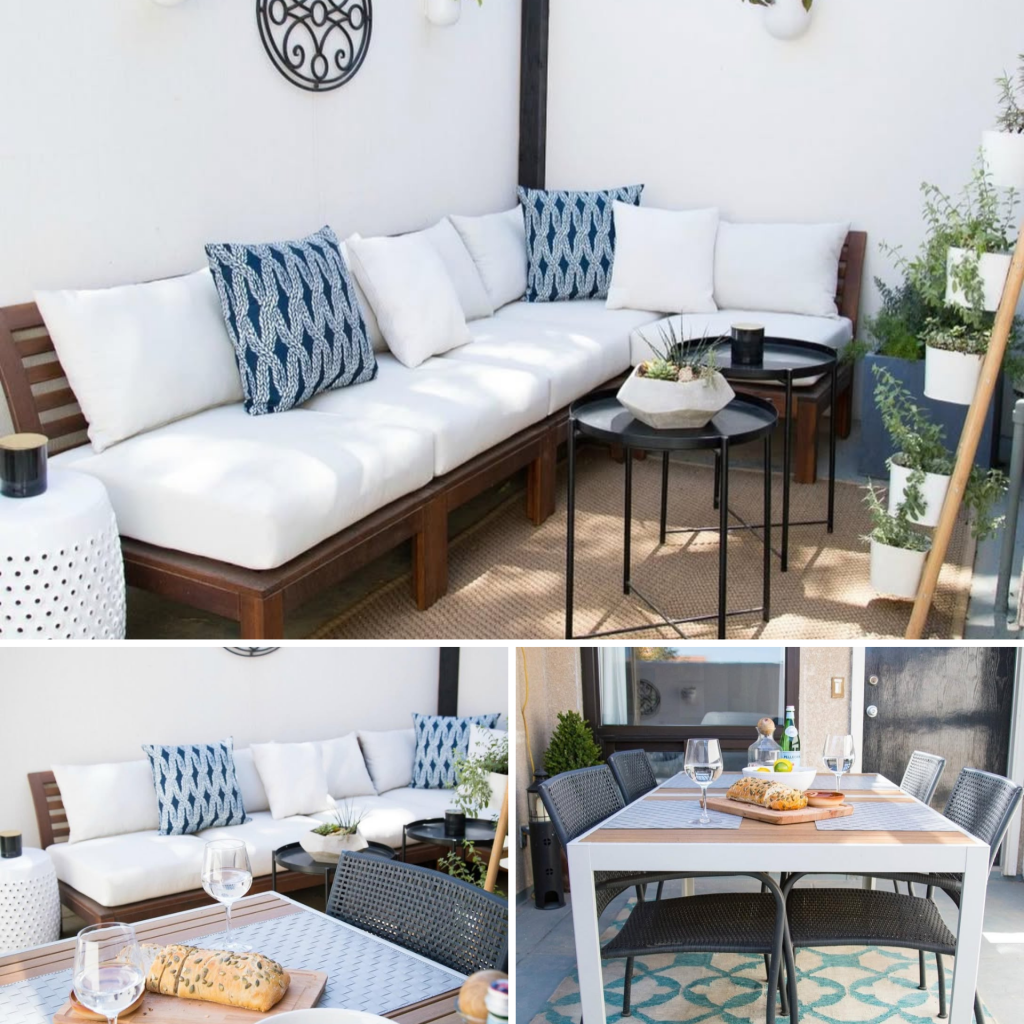
Image: https://www.instagram.com/thedesignsouk/
What Makes It Unique
This design ingeniously divides an awkward, L-shaped space into two distinct, functional zones: a conversation area and a dining area. This separation maximizes the utility of the patio and prevents it from feeling cramped. The use of a consistent color palette (white, black, and blue) ties both spaces together, creating a cohesive and well-designed outdoor living area. The low-profile furniture and a variety of textures help to keep the space from feeling cluttered.
Materials Needed
- Modular L-shaped sofa
- Outdoor dining table and chairs
- Outdoor rugs
- Wall-mounted planters
- Decorative wall art
- String lights
- Side tables
How to Do It
- Define the Zones. Use the natural “L” shape of the patio to create two separate areas. Place a large sectional sofa on one side for a relaxing lounge area, and a dining table with chairs on the other for meals.
- Anchor with Rugs. Use a different outdoor rug for each zone. This helps to visually separate the spaces while also adding comfort and a pop of color.
- Use Wall Space Wisely. Mount planters on the wall to add greenery without taking up precious floor space. Decorative wall art can also be used to add personality and visual interest.
- Add Functionality. Use nesting side tables or a small coffee table in the lounge area for drinks and snacks. Ensure the dining table is a good size for the space without overpowering it.
- Create Ambiance. A simple wooden pergola with string lights is a great way to add overhead structure and a cozy, inviting glow for nighttime use.
6. Low-Maintenance Paver Patio

Image: https://www.instagram.com/bobbykdesignsstl/
What Makes It Unique
This design focuses on creating a multi-level, low-maintenance space by using different types of pavers. The use of two paver styles and colors creates a visual distinction between the main patio and the border, adding depth and a custom look. The surrounding river rock and sparse, hardy plantings eliminate the need for extensive landscaping or a large grass area, making it an excellent, easy-to-care-for option.
Materials Needed
- Large-format concrete pavers
- Smaller, contrasting-color pavers for the border
- River rock or decorative stones
- Edging stones or bricks
- Small, low-maintenance plants
- Small bistro set
How to Do It
- Prepare the Base. After removing the old deck, level and compact the ground. Lay down a layer of gravel and sand to create a stable base for your pavers.
- Lay the Pavers. Begin by laying the main patio pavers. Work from the center outward to ensure they are evenly spaced. Use a level to check for a slight slope away from the house to allow for proper drainage.
- Install the Border. Once the main patio is laid, install a border of smaller, contrasting-colored pavers to create a clean, finished look and define the space.
- Add the Landscaping. Secure the patio with edging stones or bricks. Fill the surrounding areas with river rock or other decorative stones. Plant small, low-maintenance shrubs or perennials that will thrive in your climate.
- Place the Furniture. Arrange a small bistro set on the patio, creating a simple spot for dining or enjoying a morning coffee.
7. Shaded Bistro Patio
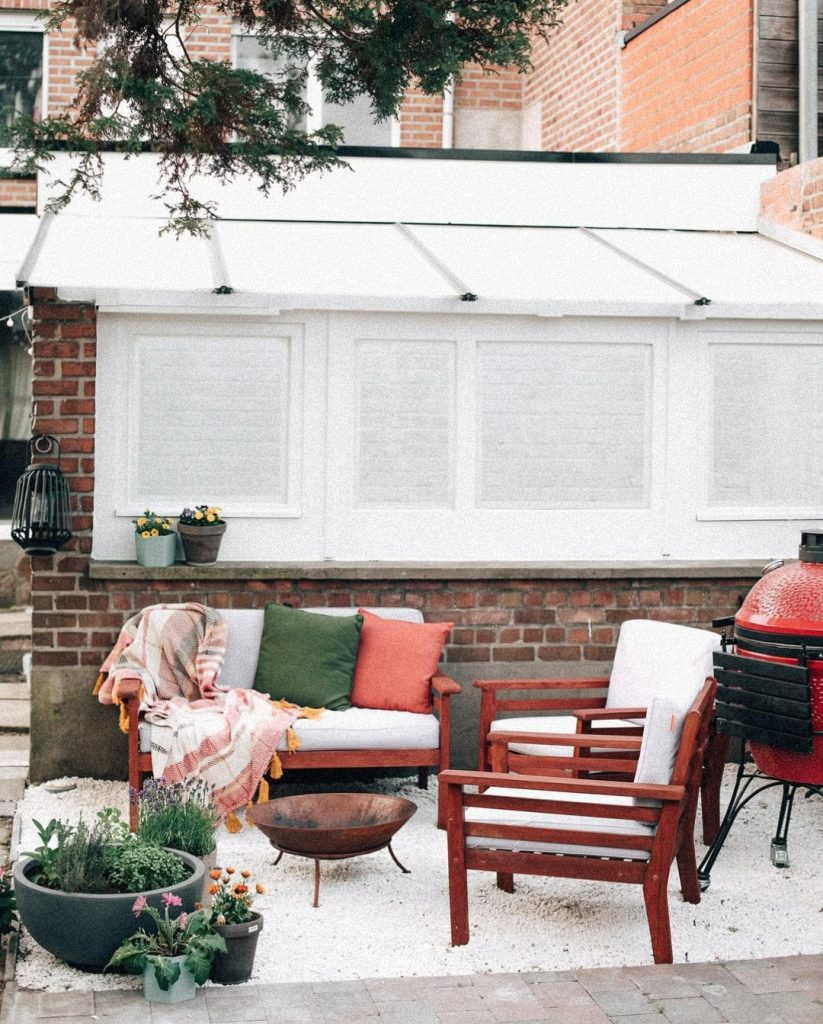
Image: https://www.instagram.com/everyday_marta/
What Makes It Unique
This patio uses a dedicated dining set and a large, off-center umbrella to create a shaded, intimate nook for meals. The black and white cushions on the furniture and the black trim of the rug create a striking visual contrast that adds a sophisticated touch. The space is kept minimal, focusing on functionality and a cozy feel without adding clutter. It’s a great example of how you can create a highly functional outdoor dining space even in a small area.
Materials Needed
- Bistro table and chairs
- Off-center patio umbrella
- Outdoor rug
- Patio lights or lanterns
- Potted plants
- Outdoor cushions
How to Do It
- Select the Furniture. Choose a small table and a couple of chairs that fit your space comfortably. Wicker or metal furniture in a dark color can provide a stylish contrast against a lighter wall.
- Add a Shade Source. Place an off-center umbrella base next to the table. This type of umbrella provides shade without a central pole that can get in the way.
- Use a Rug to Define the Space. Lay down an outdoor rug under the table and chairs to visually anchor the dining area. A rug with a black or dark border can help to frame the seating.
- Incorporate Potted Plants. Use potted plants to add life and color to the patio. Place them in corners or next to the furniture to soften the hard lines of the space.
- Finish with Lighting and Accents. Use large lanterns or a single plant to decorate the patio. If you want to use the space at night, consider adding a single string of lights.
8. The Two-Tone Paver Patio
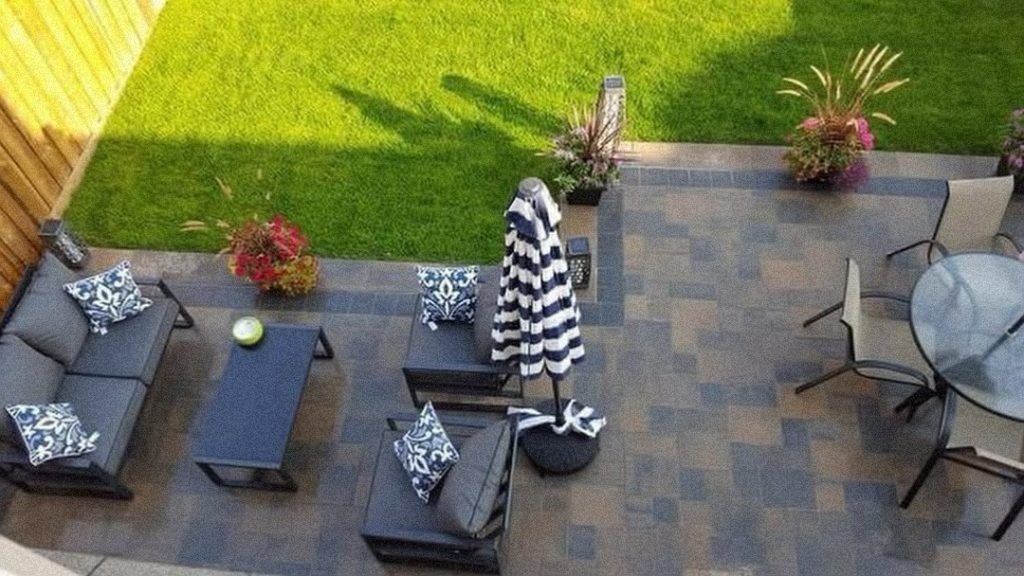
Image: https://www.instagram.com/bluemax_landscaping/
What Makes It Unique
This patio design uses dark-toned modular furniture and a striped umbrella to create a distinct, modern look that contrasts beautifully with the lush green lawn. The use of two-tone pavers adds a dynamic visual element to the flooring, separating the space into a lounging area and a dining area. This design is excellent for maximizing a small, rectangular backyard by creating multiple functions within a cohesive aesthetic.
Materials Needed
- Modular outdoor sofa
- Outdoor chairs
- Two-tone pavers
- Outdoor dining table and chairs
- Patio umbrella
- Potted plants
- Outdoor pillows
How to Do It
- Lay the Pavers. Prepare the ground and lay down pavers in a contrasting color scheme to create a two-tone pattern. This adds visual interest and helps to differentiate the seating areas.
- Place the Furniture. Arrange the outdoor sofa and chairs in a conversation area on one side of the patio. Place the dining table and chairs on the other side.
- Provide Shade. Position a patio umbrella, ideally a striped one for visual flair, to provide shade over the lounging or dining area.
- Add Greenery. Use potted plants with tall grasses or colorful flowers to add height and a natural element to the patio’s perimeter. This helps to soften the hard lines of the pavers and furniture.
- Accessorize for Comfort. Add outdoor pillows to the furniture to bring in a pop of color and patterns, tying the two zones together.
9. Multi-Zone Concrete Patio
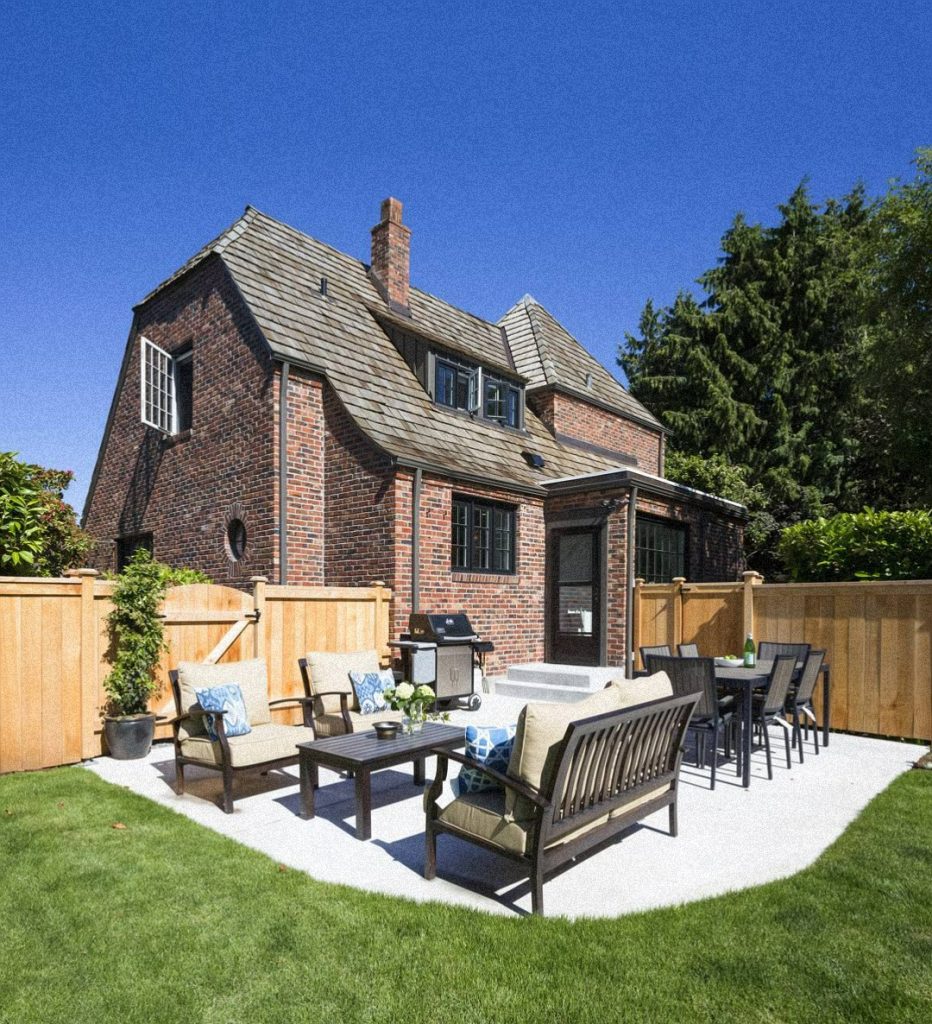
Image: https://www.instagram.com/modelremodel/
What Makes It Unique
This patio’s design cleverly utilizes a single poured concrete slab to create two distinct functional zones: a dining area and a conversation space. This is a great choice for those who want a clean, modern look with minimal maintenance. The open space between the zones and the surrounding lawn makes the backyard feel larger while still providing all the necessary elements for entertaining. This design is also highly customizable, as the furniture can be arranged in many different ways.
Materials Needed
- Poured concrete slab
- Outdoor dining table and chairs
- Outdoor sofa and chairs
- Coffee table
- Outdoor rug
- Grill
How to Do It
- Pour the Concrete. Have a concrete slab poured to create a clean, uniform surface for your patio. The organic, curved shape of this patio is an excellent choice as it softens the look and blends in with the surrounding lawn.
- Separate the Seating. Use the two distinct areas of the patio to create a dedicated dining area and a separate conversation space. This makes the patio functional for both meals and relaxing.
- Arrange the Furniture. Place a large dining table and a set of chairs in one area. In the other area, arrange a comfortable sofa and matching chairs around a low coffee table.
- Add a Grill. Position a grill within easy reach of the dining area to make outdoor cooking and serving simple.
- Use Strategic Landscaping. Keep the surrounding lawn manicured and use minimal landscaping to highlight the sleek, clean lines of the patio.
10. Modern Small-Space Decking
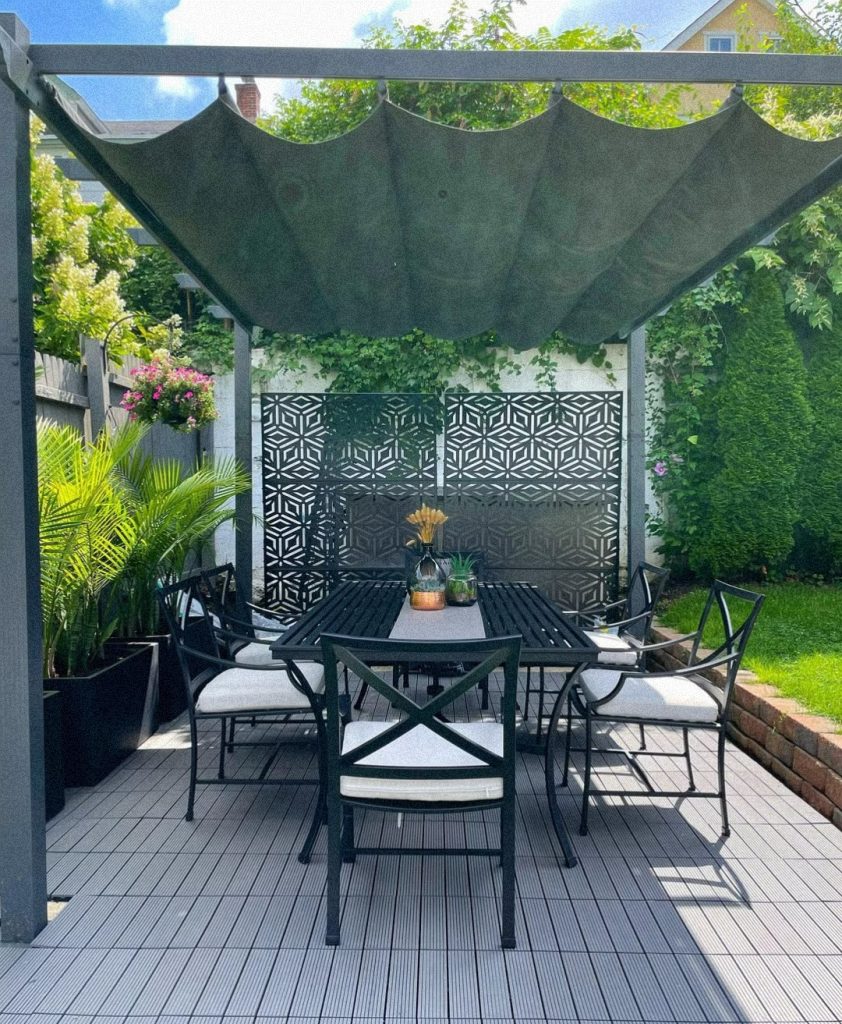
Image: https://www.instagram.com/tomnguyenfitz/
What Makes It Unique
This design features a sleek, multi-level composite deck that creates a dedicated outdoor dining room. The use of a modern pergola with a retractable or wave-like shade cloth adds a unique and functional element, offering shade when needed without a bulky roof. The decorative laser-cut screens at the back of the patio not only add a stylish touch but also provide privacy and a backdrop for the furniture, making the space feel more enclosed and intimate.
Materials Needed
- Composite decking materials
- Pergola
- Retractable shade cloth
- Outdoor dining table and chairs
- Planters
- Privacy screens
How to Do It
- Build the Deck. Install composite decking to create a low-maintenance and durable surface. Using two levels, if the space allows, adds a custom, built-in feel.
- Add a Pergola. Build a pergola over the dining area. A modern, open-top design works well. Install a retractable or custom shade cloth to provide adjustable protection from the sun.
- Install Privacy Screens. Mount decorative screens on the back wall of the patio. These screens can be made of metal or wood with an interesting pattern to add a modern flair while enhancing privacy.
- Place the Furniture. Arrange a simple, dark-colored dining set under the pergola. The contrast between the dark furniture and the light deck boards creates a striking visual.
- Finish with Greenery. Use sleek planters with tall, leafy plants to frame the space and add a touch of nature.


